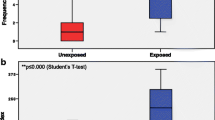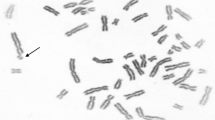Abstract
The aim of this study was to assess the frequency of chromosomal aberrations—including chromatid type aberrations (CTAs), chromosomal type aberrations, micronucleus (MN) comet assay, and XRCC1 399 Arg/Gln polymorphism—in peripheral blood lymphocytes of workers occupationally exposed to vinyl chloride monomer (VCM). A total of 52 workers and an equal number of controls were recruited into the study to explore the potential cytogenetic risk of occupational exposure to VCM. Questionnaires were administered to obtain details of habitual cigarette-smoking, alcohol-consumption pattern, and occupation, etc. The exposed subjects and controls were classified into two groups based on age (group I <40 years; group II ≥40 years), and exposed subjects were further classified based on exposure duration (>8 and ≥8 years). CTA, MN, and comet assay frequency were significantly greater in polyvinyl chloride (PVC) factory workers (p < 0.05) with long-duration work. CTA, MN, and comet assay values were found to be increased with age in exposed subjects as well as in controls, with exposed subjects showing a statistically greater degree. An extensively greater MN frequency was observed in smokers exposed to VCM than in the control group (P < 0.05). The mean tail length of exposed subjects was greater compared with controls. The study on XRCC1 399 Arg/gln polymorphism in PVC factory workers showed less significant difference in allele frequency compared with controls. In conclusion, this results of work provides evidence for an apparent genotoxic effect associated with VCM exposure. Our results reinforce the greater sensitivity of cytogenetic assays for biomonitoring of occupationally exposed populations. Statistics indicate that workers exposed to VCM are at carcinogenic risk and should be monitored for long-term adverse effects from their exposure.
Similar content being viewed by others
References
Agency for Toxic Substances and Disease Registry (2000) Toxicological profile for vinyl chloride (update). Public Health Service, United States Department of Health and Human Services, Atlanta
Agency for Toxic Substances and Disease Registry (2006) Toxicological profile for vinyl chloride. Potential for Human Exposure. Public Health Service, United States Department of Health and Human Services, Atlanta, pp 169–196
Anderson D, Yu TW, Phillips BJ, Schmezer P (1994) The effects of various antioxidants and other modifying agents on oxygen radical-generated DNA damage in human lymphocytes in the comet assay. Mutat Res 307:261–271
Balachandar V, Lakshman Kumar B, Suresh K, Sasikala K (2008) Evaluation of chromosome aberrations in subjects exposed to environmental tobacco smoke in Tamilnadu, India. Bull Environ Contam Toxicol 81:270–276
Brem R, Janet H (2005) XRCC1 is required for DNA single-strand break repair in human cells. Nucleic Acids Res 33:2512–2520
Caldecott KW (2003) XRCC1 and DNA strand break repair. DNA Repair (Amst) 2:955–969
Chanda M, Roy SK (2000) Plastic technology handbook. Marcel Dekker, New York, pp 561–566
Duell EJ, Wiencke JK, Cheng TJ, Varkonyi A, Zuo ZF, Ashok TDS et al (2000) Polymorphisms in the DNA repair genes XRCC1 and ERCC2 and biomarkers of DNA damage in human blood mononuclear cells. Carcinogenesis 21:965–971
el Ghissassi F, Barbin A, Bartsch H (1998) Metabolic activation of vinyl chloride by rat liver microsomes: low-dose kinetics and involvement of cytochrome P450 2E1. Biochem Pharmacol 55:1445–1452
Fenech M, Morley AA (1985) Measurement of micronuclei in lymphocytes. Mutat Res 147:29–36
Fenech M, Chang WP, Kirsch-Volders M, Holland N, Bonassi S, Zeiger E (2003) HUMN project: detailed description of the scoring criteria for the cytokinesis-block micronucleus assay using isolated human lymphocyte cultures. Mutat Res 534(1–2):65–75
Fracassoa ME, Doriaa D, Carrieri M, Bartolucci GB, Quintavalle S, Rosa ED (2009) DNA single- and double-strand breaks by alkaline- and immuno-comet assay in lymphocytes of workers exposed to styrene. Toxicol Lett 185:9–15
Hagmar L, Strömbergu BonassiS, Hansteen IL, Knudsen LE, Lindholm C et al (2004) Impact of types of lymphocyte chromosomal aberrations on human cancer risk: results from Nordic and Italian cohorts. Cancer Res 64:2258–2263
Hoffmann D, Patrianakos C, Brunnemann KD, Gori GB (1976) Chromatographic determination of vinyl chloride in tobacco smoke. Anal Chem 48:47–50
International Agency for Research on Cancer (2004) Tobacco smoke and involuntary smoking. IARC Monogr Eval Carcinog Risks Hum 83:1–1438
Ji F, Wang W, Xia Z, Zheng Y, Qiu Y, Wu F et al (2010) Prevalence and persistence of chromosomal damage and susceptible genotypes of metabolic and DNA repair genes in Chinese vinyl chloride-exposed workers. Carcinogenesis 31:648–653
Kumaravel TS, Jha AN (2006) Reliable Comet assay measurements for detecting DNA damage induced by ionising radiation and chemicals. Mutat Res 605(1–2):7–16
Lao TJ, Gu W, Huang Q (2008) A meta-analysis on XRCC1 R399Q and R194 W polymorphisms, smoking and bladder cancer risk. Mutagenesis 23:523–532
Lei YC, Hwang SJ, Chang CC, Kuo HW, Luo JC, Chang MJ et al (2002) Effects on sister chromatid exchange frequency of polymorphisms in DNA repair gene XRCC1 in smokers. Mutat Res 519:93–101
Li Y, Marion MJ, Zipprich J, Santella RM, Freyer G, Brandt-Rauf PW (2009) Gene-environment interactions between DNA repair polymorphisms and exposure to the carcinogen vinyl chloride. Biomarkers 14:148–155
Lindahl T, Wood RD (1999) Quality control by DNA repair. Science 286:1897–1905
Maluf SM, Erdtmann B (2000) Follow-up study of genetic damage in lymphocytes of pharmacists and nurses handling antineoplastics drugs evaluated by cytokinesis-block micronuclei analysis and single cell gel electrophoresis assay. Mutat Res 471:21–27
Mateuca R, Lombaert N, Aka PV, Decordier I, Kirsch-Volders M (2006) Chromosomal changes: induction, detection methods and applicability in human biomonitoring. Biochimie 88:1515–1531
Mateuca RA, Mathieu R, Aka PV, Bonassi S (2008) hOGG1326, XRCC1399 and XRCC3241 polymorphisms influence micronucleus frequencies in human lymphocytes in vivo. Mutagenesis 23:35–41
Moorhead PS, Novell WJ, Mellman DM, Batlips D, Hungerford A (1960) Chromosome preparations of leukocytes cultured from peripheral blood. Exp Cell Res 20:613–616
National Emission Standards for Hazardous Air Pollutants (NESHAP) (2001) Vinyl chloride subpart F, OMB Control No. 2060-0071, EPA ICR No. 0186.09 (Volume 66, Number 186)
Nowinski GP, Van Dyke DL, Tilley BC, Jacobsen G, Babu VR, Worsham MJ et al (1990) The frequency of aneuploidy in cultured lymphocytes is correlated with age and gender but not with reproductive history. Am J Hum Genet 46:1101–1111
Schmid O, Speit G (2007) Genotoxic effects induced by formaldehyde in human blood and implications for the interpretation of bio monitoring studies. Mutagenesis 22:69–74
Tice RR, Agurell E, Anderson D, Burlinson B, Hartmann A, Kobayashi H et al (2000) Single cell gel/comet assay: guidelines for in vitro and in vivo genetic toxicology testing. Environ Mol Mutagen 35:206–221
Wageh MA, Sobhy HE, Mona LG (1998) Assessment of vinyl chloride-induced DNA damage in lymphocytes of plastic industry workers using a single-cell gel electrophoresis technique. Toxicology 128:9–16
Wang Q, Ji F, Sun Y, Qiu YL, Wang W, Wu F et al (2010) Genetic polymorphisms of XRCC1, HOGG1 and MGMT and micronucleus occurrence in Chinese vinyl chloride-exposed workers. Carcinogenesis 31(6):1068–1073
Ward E, Boffetta P, Andersen A, Colin D, Comba P, Deddens J et al (2001) Update of the follow-up of mortality and cancer incidence among European workers employed in the vinyl chloride industry. Epidemiology 12:710–718
Wong RH, Wang JD, Hsieh LL, Du CL, Cheng TJ (1998) Effects on sister chromatid exchange frequency of aldehyde dehydrogenase 2 genotype and smoking in vinyl chloride workers. Mutat Res 420:99–107
Wong RH, Chen PC, Du CL, Wang JD, Cheng TJ (2002a) An increased standardized mortality ratio for liver cancer among polyvinyl chloride workers in Taiwan. Occup Environ Med 59:405–409
Wong RH, Du CL, Wang JD, Chan CC, Luo JC, Cheng TJ (2002b) XRCC1 and CYP2E1 polymorphisms as susceptibility factors of plasma mutant p53 protein and anti-p53 antibody expression in vinyl chloride monomer-exposed polyvinyl chloride workers. Cancer Epidemiol Biomark Prev 11:475–482
Acknowledgments
The authors thank the Management of Bharathiar University for providing infrastructure facilities for this research work as well as the workers who volunteered to take part in this study.
Author information
Authors and Affiliations
Corresponding authors
Rights and permissions
About this article
Cite this article
Kumar, A.K., Balachandar, V., Arun, M. et al. A Comprehensive Analysis of Plausible Genotoxic Covariates Among Workers of a Polyvinyl Chloride Plant Exposed to Vinyl Chloride Monomer. Arch Environ Contam Toxicol 64, 652–658 (2013). https://doi.org/10.1007/s00244-012-9857-1
Received:
Accepted:
Published:
Issue Date:
DOI: https://doi.org/10.1007/s00244-012-9857-1




